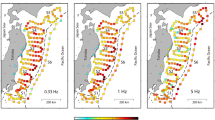Abstract
A transient technique was used for estimating the bottom-instrument response function in experiments with bottom seismographs (OBS) in deep ocean. The sharp mechanical impacts on bottom seismograph usually induced by bottom displacements under the instrument (microshocks) are suggested as rough analogues of the impulses for the bottom-instrument system transient calibration. It has been found that microshocks has usually sufficiently small duration to be used for coupling characteristics estimates. Test measurements have shown that in many cases this method makes it possible to distinguish spectral features characterising earthquakes and seismic noise wavetrains from those which are caused by coupling resonances of the OBS-sediment inter-face.
Similar content being viewed by others
References
AranovichZ. I. and MelamudM. (eds.), 1976, Impulse Calibration of Seismometric Channels, Moscow, Nauka, 236 pp. (in Russian).
BrocherT. M. and IwatakeB. T., 1982, Sources of Low-Frequency Ambient Seafloor Noise on a Continental Shelf, Bull. Seismol. Soc. Amer. 72, 1129–1142.
BuskirkR. E., FrohlichC., LathamG. V., ChenA. T., and LawtonJ., 1981, Evidence that Biological Activity Affects Ocean Bottom Seismograph Recordings, Mar. Geophys. Res. 5, 189–205.
EspinosaA. E., SuttonG. H., and MillerH. J., 1962, A Transient Technique for Seismograph Calibration, Bull. Seismol. Soc. Amer. 52, 767–779.
Feofilaktov, V. D., 1983, Earthquake Recording by means of Bottom Stations. Some Questions of Methodology, in Seismological Studies of the World Ocean, Moscow, pp. 57–64 (in Russian).
NeprochnovYu. P., 1980, 23rd Cruise of Research Vessel ‘Dmitry Mendeleev’. Okeanologiya 20, 360–362 (in Russian).
OstrovskyA. A., 1987, A Technique for Estimating the Coupling Characteristic of a Bottom Seismograph, in Technology and Methodology for the Study of the World Ocean, Summaries of Reports of an All-Union School, Moscow, Izd. IOAN SSSR, Vol. 1, p. 138. (in Russian).
OstrovskyA. A., 1989, On the Nature of Microshocks Recorded by Bottom Seismographs. Mar. Geophys. Res. 11, 113 (this issue).
OtnesR. K. and EnochsonL. 1978, Applied Time Series Analysis. Wiley, New York.
RykunovL. N. and SedovV. V., 1967, Bottom Seismograph, Izv. AN SSSR, Fizika Zemli (Solid Earth) 8, 83–87.
SuttonG. H., LewisB. T. R., EwingJ., DuennebierF. K., IwatakeB. T., and TuthillJ. D., 1981, An Overview and General Results of the Lopez Island OBS Experiment, Mar. Geophys. Res. 5, 3–34.
SuttonG. H., DuennebierF. K., and IwatakeB. T., 1981a, Coupling of Ocean Bottom Seismometers to Soft Bottoms, Mar. Geophys. Res. 5, 35–52.
Author information
Authors and Affiliations
Rights and permissions
About this article
Cite this article
Ostrovsky, A.A. The estimation of ocean bottom seismographs' coupling characteristics by means of microshock recordings. Mar Geophys Res 11, 119–127 (1989). https://doi.org/10.1007/BF00285663
Received:
Issue Date:
DOI: https://doi.org/10.1007/BF00285663




